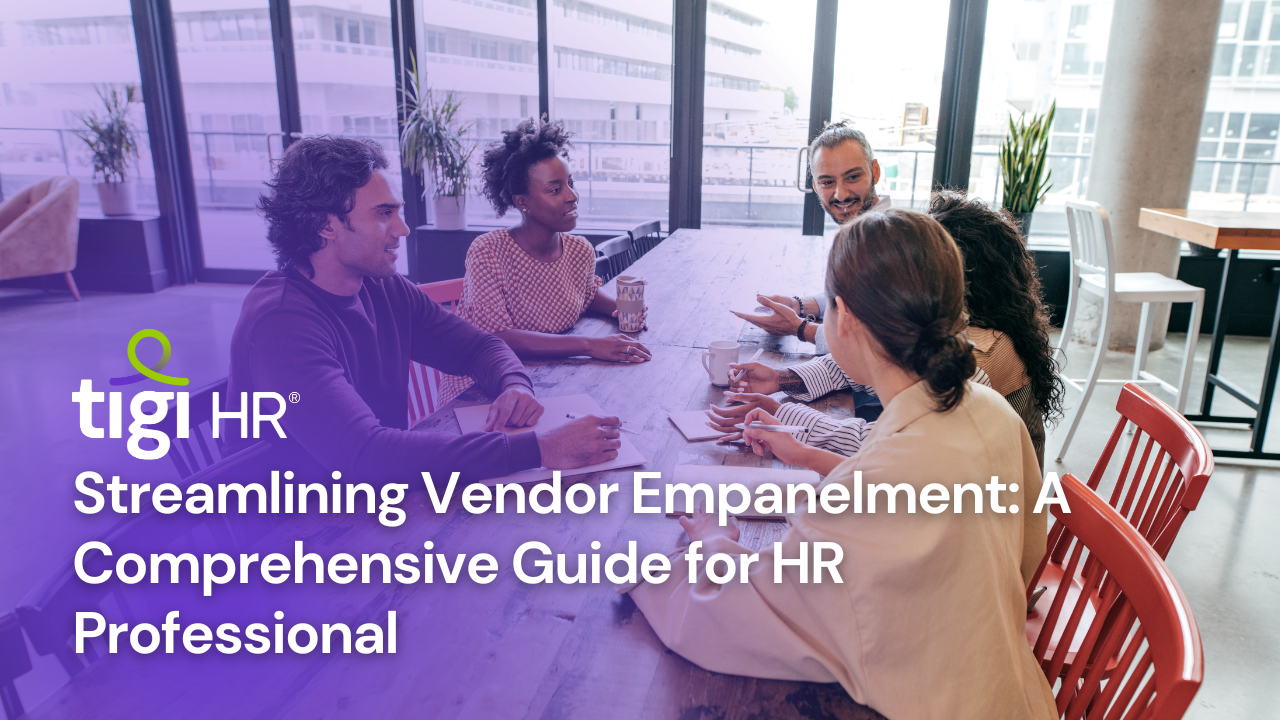Introduction to Vendor Empanelment in HR
In the realm of Human Resources (HR), managing vendor relationships and ensuring they align with an organization’s goals is a crucial function. Vendor empanelment, often referred to as vendor onboarding, is the foundational process through which HR professionals establish, maintain, and optimize partnerships with external vendors, suppliers, or service providers.
Vendor empanelment involves the meticulous evaluation and selection of vendors to meet an organization’s specific needs. It serves as the gateway for vendors to become official partners of the company, and it entails a set of standardized procedures, criteria, and documentation that vendors must adhere to.
This process is pivotal in today’s business landscape as organizations increasingly rely on external partners to deliver various services, from recruitment and training to technology solutions and facility management. Effective vendor empanelment not only ensures that the vendors meet compliance and quality standards but also guarantees that their offerings align with the company’s strategic objectives.
Moreover, it is the first step in establishing a productive and mutually beneficial partnership. HR professionals play a central role in orchestrating this process by defining the vendor empanelment strategy, crafting the vendor criteria, conducting due diligence, and managing vendor relationships.
The Importance of Vendor Empanelment
In the complex web of modern business operations, the significance of vendor empanelment cannot be overstated. This process serves as the linchpin in the relationship between an organization and its external partners, making it an integral facet of efficient HR management.
Vendor empanelment is essentially the gatekeeper that ensures the vendors chosen are not merely providers but strategic allies. It’s not just a formality; it’s a strategic choice that impacts the company’s performance and reputation. Here are some key reasons why vendor empanelment holds such importance:
- Quality Assurance: Vendor empanelment ensures that the vendors meet specific quality, compliance, and performance standards. This safeguards the company’s interests and guarantees the delivery of quality services or products.
- Cost Management: By carefully selecting vendors through a structured empanelment process, HR professionals can negotiate favorable terms and conditions, thereby optimizing costs and resource allocation.
- Risk Mitigation: Effective vendor empanelment involves thorough due diligence, reducing the risks associated with unreliable vendors, potential legal complications, or delivery failures.
- Strategic Alignment: Vendor empanelment aligns external partners with the organization’s strategic goals. This ensures that vendors are not working in isolation but are contributing to the company’s overall success.
- Operational Efficiency: Streamlined vendor empanelment processes save time and effort, allowing HR professionals to focus on more strategic tasks rather than constantly addressing vendor-related issues.
- Vendor Accountability: Vendor empanelment establishes clear responsibilities and expectations for vendors, making them accountable for their performance.
Benefits of Streamlining Vendor Empanelment
Streamlining vendor empanelment processes within the realm of HR offers an array of tangible benefits that resonate throughout the organization. This operational optimization doesn’t just simplify paperwork; it enhances the overall efficiency and effectiveness of the vendor management ecosystem. Let’s delve into some of the prominent advantages of streamlining this crucial function:
- Time Efficiency: A streamlined vendor empanelment process reduces the time and effort spent on paperwork, administrative tasks, and repetitive procedures. This means HR professionals can swiftly evaluate and onboard vendors, dedicating more time to strategic initiatives.
- Cost Savings: Simplifying empanelment procedures minimizes resource allocation towards redundant tasks, resulting in significant cost savings. It also allows for faster vendor onboarding, ensuring that the benefits of new partnerships are realized sooner.
- Enhanced Vendor Relationships: A more efficient empanelment process contributes to a positive vendor experience. Vendors appreciate working with organizations that value their time, leading to better relationships, improved communication, and more collaborative partnerships.
- Greater Compliance and Accountability: Streamlining ensures that vendors are held to consistent standards and expectations. This heightened accountability reduces compliance risks and legal complications while fostering a culture of responsibility among vendors.
- Data-Driven Decisions: With streamlined vendor empanelment, HR professionals can collect and analyze data more effectively. This data-driven approach enables better decision-making, allowing organizations to align vendor partnerships with their strategic goals.
- Scalability and Adaptability: A well-structured empanelment process is easily scalable, accommodating the evolving needs of the organization. It’s adaptable to market changes and can swiftly incorporate new vendors or remove non-performing ones.
Key Challenges in Vendor Empanelment
Navigating the landscape of vendor empanelment in HR comes with its fair share of challenges. These hurdles are not merely roadblocks but opportunities for growth, improvement, and strategic refinement. Let’s explore some of the key challenges that HR professionals encounter in the process:
- Diversity of Vendor Ecosystem: Organizations often work with a diverse array of vendors, each with their own unique offerings and operational dynamics. The challenge lies in harmonizing and standardizing empanelment procedures to suit these variations.
- Compliance Complexities: Staying compliant with local, national, and even international regulations can be a complex endeavor. Ensuring that vendors meet all the necessary legal requirements while streamlining the process can be challenging.
- Data Security and Privacy: With the increasing focus on data security and privacy, HR professionals must carefully handle sensitive data during the vendor empanelment process, which can be challenging, especially with multiple vendors involved.
- Striking the Right Balance: Achieving the right balance between comprehensive due diligence and efficient onboarding can be a challenge. Being overly cautious can lead to delays, while being too lenient can result in risks.
- Maintaining Consistency: Keeping empanelment procedures consistent across various departments and geographies can be a significant challenge. This consistency is essential to ensure all vendors are evaluated by the same standards.
- Scalability: As organizations grow or experience fluctuations in vendor needs, scaling the empanelment process can be tricky. Adapting to these changes while maintaining efficiency is a challenge.
- Communication and Transparency: Effective communication with vendors and internal stakeholders is vital. Ensuring transparency in the empanelment process can be a challenge, especially when dealing with a high volume of vendors.
Developing a Vendor Empanelment Strategy
A well-structured vendor empanelment strategy is the compass that guides HR professionals through the complex landscape of vendor management. It’s not just a plan; it’s a blueprint for creating strong, symbiotic relationships with external partners. Let’s delve into the art of developing an effective vendor empanelment strategy:
- Understanding Organizational Objectives: The first step is to align the vendor empanelment strategy with the overarching goals of the organization. By clearly defining what the organization seeks to achieve through vendor partnerships, HR professionals can set the right course.
- Assessing Vendor Needs: Careful analysis of the organization’s needs is paramount. HR must identify which functions can be effectively outsourced to vendors and which vendors are best suited to fulfill these needs.
- Empanelment Criteria: The strategy outlines the specific criteria that vendors must meet. These criteria encompass not only the vendor’s capabilities but also their financial stability, legal compliance, and ethical standards.
- Empanelment Procedures: Defining the step-by-step process for evaluating, onboarding, and monitoring vendors is integral. This includes creating a clear timeline, roles and responsibilities, and documentation requirements.
- Risk Mitigation: A strong strategy should incorporate risk management practices. HR professionals need to identify potential risks and develop mitigation plans for vendor partnerships that may present higher risks.
- Technology Integration: Leveraging technology in the strategy can streamline the empanelment process. This may include using software for vendor assessments, document management, and communication.
- Continuous Improvement: The strategy should be dynamic, allowing for ongoing assessment and improvement. Regularly evaluating the effectiveness of the empanelment strategy is essential for adapting to changing circumstances.
Identifying the Right Vendors for Your Organization
Selecting the right vendors for your organization is akin to finding the perfect puzzle piece that seamlessly fits into your broader operational picture. It’s not just a choice; it’s a strategic decision that can significantly impact your company’s performance. Let’s explore the art of identifying the right vendors:
- Needs Assessment: Before delving into the vendor selection process, HR professionals must conduct a thorough needs assessment. This involves understanding the specific requirements, gaps, or areas where external expertise is essential.
- Vendor Profiling: Once needs are identified, the process of vendor profiling begins. This entails categorizing potential vendors based on their specializations, capabilities, and the services or products they offer.
- Qualification Criteria: Defining vendor qualification criteria is crucial. These criteria go beyond basic capabilities to encompass factors such as financial stability, reputation, track record, and adherence to industry standards.
- Market Research: Conducting in-depth market research to identify potential vendors is a key step. It involves seeking recommendations, reading reviews, and staying informed about market trends.
- Request for Proposal (RFP): Issuing well-structured RFPs to potential vendors is essential. These documents outline your organization’s needs and expectations, allowing vendors to respond with their proposals and capabilities.
- Evaluation Process: The evaluation phase includes reviewing vendor proposals, conducting due diligence, and shortlisting candidates based on their alignment with your organization’s goals.
- Site Visits and References: Going beyond the paperwork, visiting vendor sites and checking references can provide invaluable insights into the vendors’ operations, culture, and reliability.
- Collaborative Compatibility: Assess the potential for a strong collaborative relationship. It’s important to evaluate how well the vendor’s working style and culture align with your organization’s values and expectations.
Creating Vendor Empanelment Criteria
Crafting effective vendor empanelment criteria is akin to sculpting a finely tuned instrument for harmonious vendor selection. These criteria serve as the blueprint for identifying vendors that are not just capable but also aligned with your organization’s vision. Let’s delve into the art of creating robust vendor empanelment criteria:
- Strategic Alignment: The foremost consideration is aligning vendor criteria with the organization’s strategic goals. What specific attributes or capabilities are vital for achieving your company’s mission and objectives?
- Comprehensive Capabilities: Vendor empanelment criteria must encompass an array of capabilities. These can range from technical proficiency and industry expertise to operational capacity and geographical reach.
- Quality Standards: Define the quality benchmarks that vendors must meet. This can include industry certifications, performance metrics, and adherence to compliance standards.
- Financial Stability: Ensuring vendors are financially stable is a key element. Criteria should cover aspects such as financial health, creditworthiness, and a proven track record of fiscal responsibility.
- Legal and Ethical Standards: Incorporate criteria that evaluate vendors’ legal compliance and ethical conduct. This includes adherence to laws and regulations, as well as ethical business practices.
- Scalability and Flexibility: Given the dynamic nature of business, criteria should consider a vendor’s ability to scale operations and adapt to changing organizational needs.
- Innovation and Technology: In today’s tech-driven landscape, evaluate vendors’ innovative capabilities and their alignment with your organization’s technological roadmap.
- Sustainability and Environmental Practices: Incorporating sustainability criteria can reflect your organization’s commitment to environmental responsibility and ethical sourcing.
Vendor Assessment and Due Diligence
Vendor assessment and due diligence are the meticulous processes that serve as the organizational gatekeepers, ensuring that vendors entering your ecosystem are not only capable but also reliable. It’s akin to a detective’s work, where every detail matters. Let’s explore the intricacies of this essential step:
- Comprehensive Evaluation: Vendor assessment is a comprehensive appraisal that delves into every aspect of the vendor’s capabilities. This includes scrutinizing their track record, references, and operational processes.
- Risk Mitigation: Due diligence is your protective shield. It involves identifying and mitigating potential risks associated with the vendor, whether they pertain to financial stability, legal compliance, or operational reliability.
- Financial Analysis: Assessing the financial health of a vendor is crucial. It involves a deep dive into their financial statements, creditworthiness, and overall fiscal stability. This step ensures that your organization is protected from financial uncertainties.
- Legal Compliance: Due diligence covers the legal aspects of a vendor’s operations. This includes verifying that they meet all necessary legal requirements, licenses, and regulatory obligations.
- Reference Checks: Talking to existing or former clients of the vendor provides invaluable insights into their performance, reliability, and the quality of their service or products.
- Operational Capabilities: Assessing the vendor’s operational capacity is vital. This includes evaluating their infrastructure, resources, and ability to meet your organization’s specific needs.
- Cybersecurity and Data Handling: In an age of data breaches, due diligence must cover the vendor’s cybersecurity measures and their ability to handle sensitive data securely.
The Role of Technology in Vendor Empanelment
In the evolving landscape of vendor empanelment, technology has emerged as the dynamic force that not only streamlines processes but also enhances the efficiency and effectiveness of this critical HR function. It’s akin to the catalyst that propels your vendor management to new heights. Let’s explore the pivotal role of technology in vendor empanelment:
- Automated Workflows: Technology enables the automation of routine, repetitive tasks in vendor empanelment. This includes document management, communication, and follow-up processes, reducing manual efforts and associated errors.
- Data Analytics: Advanced analytics tools can help HR professionals make data-driven decisions during vendor selection and performance evaluation. This can lead to more informed and strategic choices.
- Centralized Information: Modern technology allows for centralized storage and easy retrieval of vendor-related information. This ensures that all stakeholders have access to up-to-date and accurate data.
- Communication and Collaboration: Collaborative platforms and communication tools foster seamless interaction between HR professionals, vendors, and internal stakeholders, enhancing transparency and efficiency.
- Document Management: Technology simplifies document management, making it easier to maintain, organize, and retrieve all empanelment-related documents, from contracts to compliance records.
- Vendor Assessment Tools: Specialized software and tools can assist in vendor assessments by providing structured evaluation criteria, automating scoring, and generating reports for decision-making.
- Monitoring and Performance Metrics: Technology allows for real-time monitoring of vendor performance, tracking key performance indicators (KPIs), and generating performance reports, helping HR professionals in ongoing evaluation.
Vendor Onboarding Best Practices
Vendor onboarding is the bridge that connects your organization with its external partners, and ensuring a smooth crossing is imperative for a successful relationship. It’s the process of not just introducing vendors but integrating them seamlessly into your operations. Let’s explore the best practices for effective vendor onboarding:
- Clear Expectations: Establishing clear expectations from the outset is crucial. Define roles, responsibilities, deliverables, and key performance indicators (KPIs) to avoid misunderstandings.
- Structured Training: Provide comprehensive training to vendors about your organization’s processes, systems, and culture. This ensures they understand your requirements and can align their operations accordingly.
- Documentation and Compliance: Ensure that all necessary documents, contracts, and compliance standards are met during the onboarding process. This includes legal and regulatory requirements.
- Communication Channels: Set up effective communication channels, so that vendors can easily reach out with questions, concerns, or requests. A dedicated point of contact can facilitate smooth communication.
- Testing and Validation: Conduct tests or trials to verify that the vendor’s capabilities align with your expectations. This may involve pilot projects to gauge their performance.
- Performance Monitoring: Implement a system for continuous performance monitoring. Regularly assess the vendor’s performance against agreed-upon KPIs and provide feedback.
- Feedback Mechanism: Create a feedback loop, allowing both your organization and the vendor to provide input and make necessary adjustments for improvement.
- Conflict Resolution: Develop a clear conflict resolution mechanism to address disputes or disagreements promptly. This ensures that issues are resolved amicably and do not escalate.
Vendor Performance Evaluation
Vendor performance evaluation is akin to the compass that keeps your organization’s vendor relationships on course. It’s not just a routine checkup; it’s a systematic assessment that ensures vendors continue to meet your expectations and contribute to your success. Let’s explore the art of vendor performance evaluation:
- Defining Key Performance Indicators (KPIs): The first step is defining the specific KPIs that align with your organization’s goals. These metrics can encompass service quality, timeliness, cost-efficiency, and compliance.
- Data Collection and Analysis: Gathering data on vendor performance is crucial. This involves not only quantitative data but also qualitative assessments, including client feedback and vendor self-assessments.
- Regular Reviews: Conduct regular performance reviews, ensuring that these evaluations are not just annual events but ongoing processes. Regularity keeps vendor performance on your radar.
- Scoring and Feedback: Develop a structured scoring system to quantitatively evaluate performance. Provide constructive feedback to vendors based on these scores, fostering continuous improvement.
- Performance Meetings: Schedule performance meetings with vendors to discuss evaluations, feedback, and strategies for enhancement. This open dialogue cultivates collaborative relationships.
- Performance Improvement Plans (PIPs): When performance falls short, establish Performance Improvement Plans (PIPs) outlining specific corrective actions and timelines.
- Benchmarking: Compare vendor performance against industry benchmarks and best practices to gain insights into areas that need improvement.
Vendor Empanelment Policy and Procedures
A robust vendor empanelment policy and well-defined procedures are the rulebook that ensures vendor partnerships operate harmoniously and efficiently. Think of it as the constitution that governs these vital relationships within your organization. Let’s explore the importance of a vendor empanelment policy and the procedures that bring it to life:
- Policy Development: A vendor empanelment policy is the foundational document that outlines the principles, values, and objectives guiding vendor selection and management. It sets the tone for your vendor partnerships.
- Procedure Documentation: Procedures break down the policy into actionable steps. They provide a structured framework for HR professionals to follow during vendor empanelment, ensuring consistency and adherence to the policy.
- Compliance and Risk Mitigation: The policy and procedures serve as a bulwark against legal and operational risks. They establish compliance standards and due diligence processes that protect your organization.
- Role Clarification: These documents clearly define the roles and responsibilities of HR professionals and other stakeholders involved in vendor empanelment. This helps avoid misunderstandings and ensures everyone knows their duties.
- Consistency and Transparency: Having established procedures ensures that vendor empanelment is consistent across departments and locations, fostering transparency and fair treatment of all vendors.
- Scalability: The policy and procedures should be scalable to adapt to the organization’s growth and evolving vendor needs. They should be dynamic, allowing for adjustments when necessary.
Legal and Compliance Aspects of Vendor Empanelment
Navigating the intricate world of legal and compliance aspects within vendor empanelment is akin to ensuring that your organization’s vendor relationships remain on the right side of the law. It’s not merely a checkbox; it’s the safeguard that protects your organization from potential legal entanglements and liabilities. Let’s delve into the critical considerations of legal and compliance aspects in vendor empanelment:
- Regulatory Adherence: The first and foremost step is understanding and complying with the relevant regulations, laws, and industry standards. This encompasses local, national, and international legal requirements.
- Contractual Agreements: Legal aspects of vendor empanelment involve drafting, reviewing, and executing contracts. These contracts must be meticulously crafted to outline responsibilities, deliverables, and terms that safeguard your organization.
- Data Protection and Privacy: Given the increasing focus on data security and privacy, it’s essential to ensure that vendors handle sensitive data in compliance with applicable data protection laws. This includes measures such as GDPR and HIPAA.
- Intellectual Property Rights: Addressing intellectual property rights is crucial. Contracts should specify who owns the intellectual property created during the partnership and how it can be used.
- Dispute Resolution: A well-defined dispute resolution mechanism must be in place to address any legal disagreements that may arise during the vendor relationship. This mechanism helps prevent legal disputes from escalating.
- Audit and Documentation: Maintain comprehensive documentation of all legal aspects, including contracts, compliance records, and audit reports. This documentation is essential for regulatory and legal purposes.
In conclusion, the journey through the intricacies of vendor empanelment is a vital expedition for HR professionals. This comprehensive guide has illuminated the path, offering insights into key facets and best practices that contribute to successful vendor management. From the foundational introduction to the strategic alignment of vendor partnerships, and the importance of technology to the critical evaluation of vendor performance, this guide has provided a roadmap for HR professionals to navigate the complexities of vendor empanelment.
The emphasis on clear criteria, policy, and procedures ensures that vendor relationships align with organizational goals, remain legally sound, and foster transparent, efficient, and scalable collaborations. Furthermore, the guide underscores the need for open communication, accountability, and the ability to adapt to changing business landscapes.
In today’s dynamic business environment, the ability to streamline vendor empanelment processes is not a mere advantage but a strategic imperative. HR professionals are pivotal in executing these practices, ensuring that vendor partnerships go beyond transactions to become long-term, value-driven collaborations. By meticulously applying the insights offered here, HR professionals can orchestrate vendor empanelment that elevates their organizations, fostering an ecosystem where external partners contribute significantly to their overall success.
HR Compliance Essentials: Navigating Legal Challenges
Explore the intricacies of HR compliance, where adherence to employment laws is just the beginning. Discover how nurturing a culture of respect and fairness is essential for organizations. Dive into the legal challenges faced by HR professionals in today’s dynamic workplace, and learn how proactive strategies can ensure long-term success.
Find trusted recruitment agencies : Click here
.





